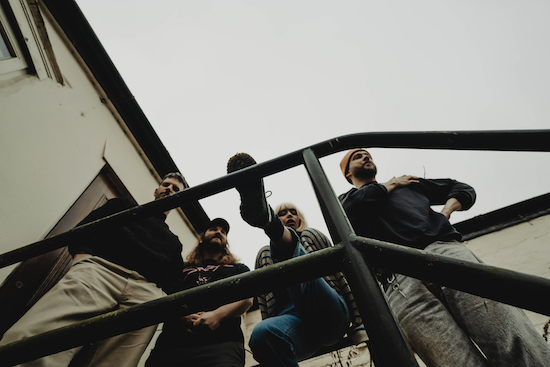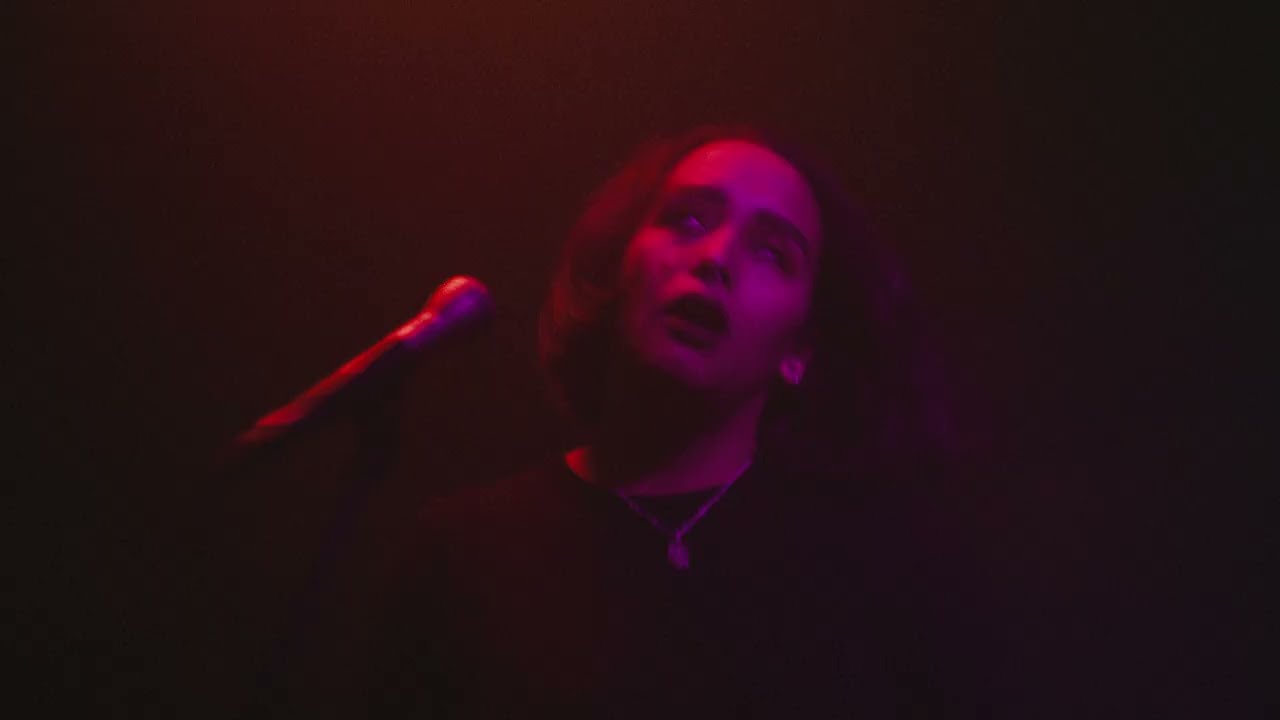Photos by Harry Steel
On their debut album I’ve Seen A Way, Mandy, Indiana explore political disillusionment through a bricolage of noise, post punk and electronic dance music. Led by Valentine Caulfield’s expressive vocals in her native French, the album places far-ranging textures, genre signifiers and recording environments – including a cave and a shopping centre – in constant, dramatic contrast with each other. “This is an album where heads butt and things clash,” explains guitarist and producer Scott Fair. “Some things were recorded on high end gear, and others on phones – it’s supposed to be nasty, and to not work.”
I’ve Seen A Way is held together, in part, by a pervading interest in marrying ideas from noise-rock with various shades of electronic dance music. Searing guitars and live drums are placed in conversation with electronic beats, acid synths and handclaps. The results range from techno stomper ‘Peach Fuzz’ to the noirish, downtempo groove of ‘The Driving Rain (18)’. While Fair notes these genres’ shared qualities as “very visceral, and about moving people physically,” their union in the album is part of a grander endeavour. “What this record is trying to achieve, is to bring together things that aren’t necessarily familiar.”
To further these experiments, the group sought the help of two differing artists with shared experience of merging noise, punk and techno: Giant Swan’s Robin Stewart, and Gilla Band’s Daniel Fox. “The idea of Giant Swan was a huge leaping off point for Mandy, Indiana,” Fair says of the Bristol duo, who splice warped vocals into a muscular, punk-inspired conception of dance music. The influence of Dublin noise-rock group Gilla Band – whose embrace of electronica dates back to their breakthrough cover of Blawan’s ‘Why They Hide Their Bodies Under My Garage?’ – is similarly acknowledged by Fair. “They feel like a Velvet Underground to me – I’m seeing their influence everywhere.” These artists separately helped Fair finesse the production on different parts of the album, with their contrasting approaches seen as supporting its patchwork character. “It’s supposed to sound like a weird sound collage anyway, so it adds to it that there’s these different touches.”
This juxtaposition of harsh, aggressive textures with ideas from electronic dance music – with its connotations of communal celebration and liberation – also serves the album’s political themes. “I’m of the opinion that, at this point in time, if you’re not angry then you’re not paying attention,” Caulfield says. “If you’ve been following French politics at all, half the country is on fire,” referencing the recent nationwide protests over pension reform. “In the way that dance music is trying to get people together, the anger of the record is saying we could stand together and refuse the conditions that are imposed on us,” she explains. “There’s more of us than there is of them.”
While the political convictions of I’ve Seen A Way extend beyond France, Caulfield’s lyrics are delivered entirely in her native French. The decision to do so, despite recognising the band’s current audience is primarily English-speaking, stems from her experiences performing in operas growing up. “I come from a background of people just using emotions in their voice to get a message across, rather than everyone understanding German or Italian,” she explains. This also supports her efforts to avoid prescriptive, reductive narratives in the lyrics’ political messaging: ‘2 Stripe’ adopts a fairy-tale setting, depicting a servant working in a beautiful palace as an allegory for a socialist revolution. “I don’t want to be too obvious with what I do. The lyrics attempt to present situations, and ask ‘are we okay with this?’”
I’ve Seen A Way has also been shaped by the group’s interest in film scores – particularly horror and science-fiction films from the 1970s and 80s. The album’s vintage synth and organ sounds recall the likes of Ennio Morricone’s score for The Antichrist and Vangelis’ for Blade Runner, the latter of which is referenced by the title of album-opener ‘Love Theme (4K VHS)’. Beyond these superficial sounds, I’ve Seen A Way also adopts film soundtracks’ use of motifs. This can be seen in the recurrence of the organ melody from ‘Love Theme (4K VHS)’ in ‘2 Stripe’, or the moment that the gritty, distorted vocals buried in ‘Mosaick’ are reimagined in ‘The Driving Rain (18)’ as a wonderfully synthetic, autotuned pop lead. “You already have the idea of a melody in your head, and you get it again in a different context” Fair explains. “It gives you a different emotional reaction because you’re hearing something familiar, but it’s done in a different way.”
This love of cinema also influenced the album’s unusual recording process. In the same way that filmmaking employs existing, real-world settings to present a fictional environment, I’ve Seen A Way was largely recorded ‘on location’. “We physically wanted to be in these different spaces, believing it might inspire our performance or the production,” Fair explains. The making of ‘Love Theme’ was inspired by a previous day of recording in the Wookey Hole Caves in Somerset. “This cave diver came up while we were recording drums – he had no idea there was going to be a band in that cave. I thought that would be really interesting from his perspective, to hear the drums filtering as you come up through the water; we needed to make a song that did that.” Fair acknowledges the decision to record in this way presented risks. “It’s hard to manipulate things that aren’t recorded in a controlled environment, but it was those kinds of limitations I was interested in working with. I didn’t want it to sound like anything else.”

A colourful example of this approach is Caulfield’s yelps on album highlight ‘Peach Fuzz’. The band were in Bristol to perform with local acts Scalping and Fever 103°, who took them out for some pre-gig drinks. “We walked through the big shopping centre in the centre of Bristol, and Paul from Fever 103° said the place had amazing acoustics,” Caulfield explains. “I started filming myself shouting in it, and that’s what the sound is.”
This bombastic, brutal track occurs between ‘Iron Maiden’ and ‘(ノ>ω<)ノ :。・::・゚’★,。・::♪・゚’☆ (Crystal Aura Redux)’. While these two tracks are disparate sonically – the former centring upon an isolated, heavily-distorted guitar line and the latter upon warm, lush electronics – they share an open-hearted, inquisitive quality. This underlines how the album’s bricolage approach extends to its emotional palette, setting toughness alongside vulnerability. “The album originally followed a narrative structure, partially inspired by the Gaspar Noé film Climax,” Fair explains, referencing a psychological horror in which several people at a party are spiked with a hallucinogen. “That part of the album is about being at your worst and most vulnerable, then being able to come back from that, and then experiencing vulnerability in a different way.” While the album broadly moved away from this narrative structure, the stark emotional dynamism remained. “There are a lot of those peaks and troughs.”
Mandy, Indiana have recently faced the challenge of presenting this sprawling, complex album in a live setting when using a simple setup of vocals, guitar, synths and drums. “I like that we’re a band that hasn’t got a synth for every song, or that changes guitars five times a set,” explains synth-player Simon Catling. In addition to the band’s rich electronic palette, Catling is – in the absence of a dedicated bassist – chiefly responsible for the band’s low end. “I’m generally a fan of acts that get the most out of a defined setup,” he says. “There’s real enjoyment in that challenge. There’ll undoubtedly be some changes, but I think we’re all of the mind that we’re not going to suddenly turn into Emerson Lake & Palmer.”
“It’s supposed to be loud, it’s supposed to be cathartic,” Fair adds. “It’s a place where people might be able to understand the album better, and connect with it more.” This points to the logic behind many of I’ve Seen A Way’s unorthodox decisions, including its patchwork construction, lyrical approach, and use of callbacks: the album sparks fresh curiosity at every turn, but leaves the listener to find order in it. “I think if you have to work for something, or spend more time with it,” Fair says. “It often makes the experience more worthwhile.”
Mandy, Indiana’s debut album I’ve Seen A Way is released on 19 May via Fire Talk



